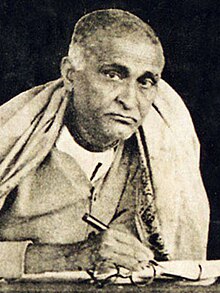গৌড়ীয় মঠ | |
 | |
| Successor | Gaudiya Mission and Sri Chaitanya Math |
|---|---|
| Established | 6 September 1920 |
| Founder | Bhaktisiddhanta Sarasvati |
| Founded at | Calcutta, British India |
| Dissolved | 1937 |
| Type | Religious organization |
| Purpose | Educational, Philanthropic, Religious studies, Spirituality |
| Headquarters | Calcutta, British India |
| Location |
|
Region served | British India British Burma London, UK Berlin, Germany |
Official languages | Bengali, English |
| Affiliations | Gaudiya Vaishnavism |

| Part of a series on |
| Vaishnavism |
|---|
 |
The Gaudiya Math (/mʌt/, /mɑːt/; Gauḍīya Maṭha) is a Gaudiya Vaishnava matha (monastic organisation) formed on 6 September 1920,[2][1] about 30 months after Bhaktisiddhanta Sarasvati took sannyasa, the renounced order of life. On 7 March 1918,[2] the same day he took sannyasa, he established the Sri Chaitanya Math in Mayapura in West Bengal, later recognised as the parent body of all the Gaudiya Math branches.[2] Its purpose was to spread Gaudiya Vaishnavism, the philosophy of the medieval Vaisnava saint Chaitanya Mahaprabhu, through preaching and publishing.
From the beginning of Chaitanya's bhakti movement in Bengal, devotees, including Haridasa Thakur and others, whether Muslim or Hindu by birth, have been participants. This openness and disregard for the traditional caste received a boost from the "broad-minded vision" of Bhaktivinoda Thakura,[3] a nineteenth-century magistrate and prolific writer on bhakti topics, and was institutionalised by his son and successor Bhaktisiddhanta Sarasvati Thakura in the twentieth-century Gaudiya Math.[3]
- ^ a b Sherbow, Paul H. (2004). "A.C. Bhaktivedanta Swami's Preaching in the Context of Gaudiya Vashnavism". In Bryant, Edwin F.; Ekstrand, Maria L. (eds.). The Hare Krishna Movement: The Postcharismatic Fate of a Religious Transplant. New York: Columbia University Press. pp. 129–46. ISBN 0-231-12256-X. Archived from the original on 22 April 2023. Retrieved 10 February 2022. p. 130.
- ^ a b c Devamayī dāsi, "A Divine Life: Śrīla Bhaktisiddhānta Saraswatī Ṭhākura Prabhupāda" in Prabhupada Saraswati Thakur: The Life & Precepts of Śrīla Bhaktisiddhānta Saraswatī, Mandala Publishing, Eugene, Oregon: 1997, pp. 24, 26, 49. ISBN 978-0-945475-10-1.
- ^ a b Sherbow 2004, p. 139.